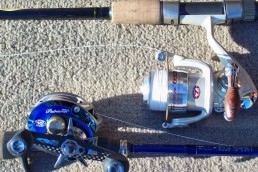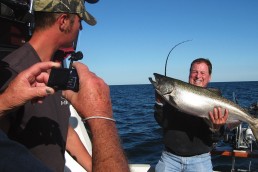Four Ways to Avoid Reel Backlash
SHARE THIS POST
Backlash: a reel nightmare
Every angler who uses spinning gear has experienced long skeins of line jamming against the first guide, resulting in a tangle that rarely can be unraveled. Craig, my son, when he started using spinning gear, named the resulting mess a nine-mile backlash.
If slack line is wound onto the spool at the beginning of the retrieve, the resulting loop is what causes these tangles. No cast is perfectly flat. It puts some slack in the line. Between the lure on the water and the rod tip, the arc of the line produces a loop on the first revolution of the reel bail. As the bail continues to turn, the additional line buries the loop. You can minimize the danger of an embedded loop on the reel spool. Here’s how:
1. Don’t put too much line on the spool
Too much line on the spool is a major factor in spinning gear troubles. Spinning reels release line by letting it peel off the end of a stationary spool. Unlike the revolving spool of baitcasting reels, spinning reels have no spool inertia to slow the line. Line simply slips off the spool. If too much line is on the spool, it can slip off with little or no pressure.
2. Keep your index finger near the lip of the spool
As line peels off the end of the spool, keep your index finger near the lip of the spool. As the lure nears the water, slight pressure against the spool slows the lure and reduces the amount of slack line when the cast ends. Just as the lure strikes the water, prevent additional line from leaving the spool with finger pressure.
3. Flip the bail by hand
When spinning equipment became common, shortly after World War II, reels did not have modern bails like those on contemporary reels. Before reeling in line, anglers had to place the line manually over the roller. Stan Fagerstrom, a longtime casting instructor, removes the bails from his reels and places the cast line over the roller manually. Doing so assures him that a loop will not be wound onto the spool.
Are you enjoying this post?
You can be among the first to get the latest info on where to go, what to use and how to use it!
You don’t need to remove the bail to accomplish the same end. If the bail is flipped by turning the reel handle, slack is often part of the first revolution of the bail. Manually moving the bail into position alerts you to to any loose line about to be wound onto the spool. Simply take the hand not holding the rod and pull the bail into closed position.
An additional advantage of moving the bail manually is it reduces stress on the bail spring, a principal cause of spinning reel failure. As the bail weakens before failing altogether, the bail only closes part way. In turn, the first revolution does not bring line onto the reel under tension.
4. Raise the rod tip before the first turn of the reel handle
Tom Mann, of Eufala, Ala., was among the pioneers of tournament bass fishing. Among early B.A.S.S. anglers, Mann was the only one who relied on spinning gear. While watching Mann fish, I noticed, before he began to retrieve line, he lifted his rod tip several inches. It took me quite a while before I understood why he did it. The upright rod took up some of the slack in the cast line. Line between the rod tip and reel should have a little tension. Thus, reducing the prospect of a tangle.
None of these practices will eliminate the nine-mile backlash. But they sure will reduce the frequency of them.
Sure you have the right rod for your reel? Make doubly sure with our guide to picking the right rod.
MWO
SHARE THIS POST
Did you enjoy this post?
You can be among the first to get the latest info on where to go, what to use and how to use it!
Tim Mead
Tim Mead is an established outdoor writer and photographer with more than 500 credits in state, regional and national magazines. He is an “Excellence in Craft” award winner from both the Outdoor Writers Association of America (of which he is also vice president) and the Southeast Outdoor Press Association (as well as being past president).



